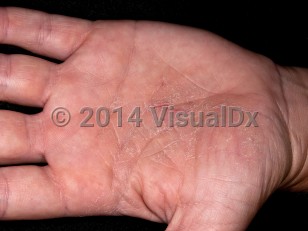Common clinical variants include:
- Chronic fissuring
- Recurrent vesicles that are often itchy (dyshidrotic)
- Hyperkeratotic (psoriasiform hand dermatitis)
- Fingertip hyperkeratosis (pulpitis)
- Interdigital – scaling and irritation along the digits
- Nummular – annular scaly plaques
Nearly all forms of hand dermatitis involve the epithelial barrier, which can occur due to both genetic and environmental factors. Disruption of the superficial stratum corneum layer and deficiencies in the protective lipid bilayer lead to transepidermal water loss and xerosis. This loss of barrier function lowers the threshold for inflammation and results in skin that is more sensitive to environmental triggers such as irritants and allergens.
Hand dermatitis affects 2%-9% of the general population and accounts for over 80% of occupation-related cutaneous disorders. More than 70% of all hand dermatitis cases are due to some combination of atopic dermatitis, allergic contact dermatitis, and irritant contact dermatitis. The condition is more prevalent among females and those in occupations that involve contact with mechanical and chemical irritants, as well as a repetitive wet-dry cycle ("wet work") of the hands associated with frequent hand washing. These occupations include agricultural workers, mechanics / automotive workers, health care professionals, food industry workers, janitors / cleaners, construction workers, painters, electricians, beauticians / hairdressers, and caretakers of newborns or older adults. See also dermatitis of nail folds.
Hand dermatitis can be subdivided according to the underlying etiology.
Common Etiologies:
- Atopic hand dermatitis – Scaly, poorly defined, pink plaques that form thin or thick lichenified fissures that develop on the dorsum of the fingers, hands, and wrist. Symptoms include intense itching, pain, and nail changes (eg, thickening of the nail fold or loss of cuticle). Family or personal history of atopy increases risk of atopic, allergic contact, and irritant contact dermatitis. Lesion sites are prone to secondary impetiginization with Staphylococcus aureus.
- Allergic contact hand dermatitis – A type IV delayed hypersensitivity reaction to an allergen developing several days after initial exposure. Characterized by itching, burning, and pain. Contact sites will develop erythematous papules and vesicles that weep and crust over. Geometric shapes, right angles, and well-demarcated borders are clues. Often follows irritant contact dermatitis and can be found anywhere on the body.
Rubber allergens
- Exposure – latex, thiuram, carba mix
- Association – gloves, health care workers
- Exposure – fragrance mix, balsam of Peru
- Association – skin care products, hair products
- Exposure – methylchloroisothiazolinone, methylisothiazolinone, quaternium-15, formaldehyde
- Association – skin care products, lubricants, household cleaning products
- Exposure – nickel, potassium dichromate, gold, cobalt chloride, chromium
- Association – jewelry, keys, coins, buttons, tools
- Exposure – neomycin sulfate, bacitracin
- Association – topical antibiotics
- Exposure – poison oak / ivy
- Association – hiking, outdoor exposure
- Irritant contact hand dermatitis – Repetitive exposure to mechanical and chemical materials that abrade, irritate, and disrupt the epithelial barrier. Irritant contact hand dermatitis tends to develop within the first few months of starting work with a frequent wet-dry cycle. Symptoms include dry skin that is itchy, tender, and burning. Over time, erythematous, scaly plaques and lichenification develop due to scratching along the dorsum and palms. Involvement of the finger webs is suggestive. Irritant contact hand dermatitis increases the risk of developing allergen sensitization and allergic contact dermatitis.
- Hyperkeratotic / psoriasiform dermatitis – Etiology is idiopathic but thought to be from the repetitive mechanical forces of friction and pressure. It develops slowly over time and is more common among men aged 40-60 years and persons with an extended history of manual labor. Hyperkeratosis is symmetrical and well-demarcated along the palms. Skin cracking and fissuring is common and may cause pain but no itching. This form of dermatitis tends to be chronic and difficult to treat effectively.
- Nummular dermatitis – Well-demarcated, erythematous, coin- or oval-shaped plaques and papules commonly on the dorsum of the hand and fingers. The plaques are mildly pruritic, asymmetric, and likely appear elsewhere on the body. Question for a history of eczema.
- Pompholyx / dyshidrotic eczema / vesicular hand dermatitis – Idiopathic, episodic recurrences of vesicles and bullae on the palms, fingers, and toes. Between episodes, the skin appears normal, but during flares it will often become intensely pruritic as collections of small vesicles form along the sides of fingers. Less commonly, large, tender bullae may form on the palms. Following episodes, skin will peel and crack over the course of several weeks.



 Patient Information for
Patient Information for 
